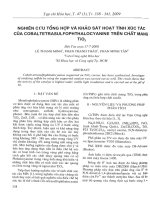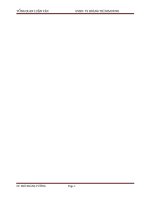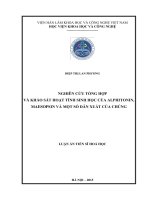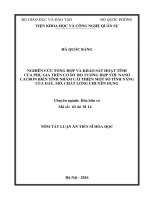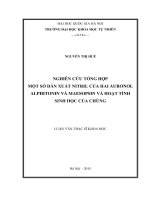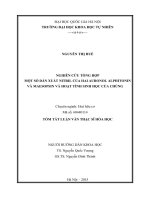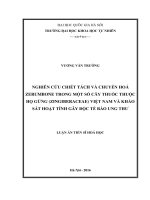Nghiên cứu chiết tách và chuyển hóa zerumbone trong một số cây thuốc thuộc họ Gừng (Zingiberaceae) Việt Nam và khảo sát hoạt tính gây độc tế bào ung thư
Bạn đang xem bản rút gọn của tài liệu. Xem và tải ngay bản đầy đủ của tài liệu tại đây (452.12 KB, 24 trang )
ĐẠI HỌC QUỐC GIA HÀ NỘI
TRƢỜNG ĐẠI HỌC KHOA HỌC TƢ̣ NHIÊN
--------
VƢƠNG VĂN TRƢỜNG
NGHIÊN CỨU CHIẾT TÁCH VÀ CHUYỂN HOÁ
ZERUMBONE TRONG MỘT SỐ CÂY THUỐC THUỘC
HỌ GỪNG (ZINGIBERACEAE) VIỆT NAM VÀ KHẢO
SÁT HOẠT TÍNH GÂY ĐỘC TẾ BÀO UNG THƢ
LUẬN ÁN TIẾN SĨ HOÁ HỌC
Hà Nội - 2016
ĐẠI HỌC QUỐC GIA HÀ NỘI
TRƢỜNG ĐẠI HỌC KHOA HỌC TƢ̣ NHIÊN
--------
VƢƠNG VĂN TRƢỜNG
NGHIÊN CỨU CHIẾT TÁCH VÀ CHUYỂN HOÁ
ZERUMBONE TRONG MỘT SỐ CÂY THUỐC THUỘC
HỌ GỪNG (ZINGIBERACEAE) VIỆT NAM VÀ KHẢO
SÁT HOẠT TÍNH GÂY ĐỘC TẾ BÀO UNG THƢ
LUẬN ÁN TIẾN SĨ HOÁ HỌC
Chuyên ngành : Hóa hữu cơ
Mã số:
62440114
Ngƣời hƣớng dẫn khoa học: 1. PGS.TS. Văn Ngọc Hƣớng
2. GS.TS. Nguyễn Đình Thành
Hà Nội - 2016
LỜI CAM ĐOAN
Tôi xin cam đoan đây là công trình nghiên cứu của riêng tôi. Các số
liệu và kết quả đƣợc nêu trong luận án là trung thực và chƣa từng đƣợc ai
công bố trong bất kỳ công trình nào khác.
Hà Nội, ngày 10 tháng 3 năm 2016
Ký tên
Vƣơng Văn Trƣờng
LỜI CẢM ƠN!
Em xin bày tỏ lòng biết ơn sâu sắc nhất đến PGS.TS. Văn Ngọc
Hướng và GS.TS. Nguyễn Đình Thành đã giao đề tài, tạo mọi điều kiện và
tận tình hướng dẫn em hoàn thành bản luận án này.
Tôi xin chân thành cảm ơn TS. Lưu Văn Chính đã nhiệt tình giúp đỡ
tôi trong quá trình làm luận án.
Tôi xin được bày tỏ lòng cảm ơn đến các thầy, các cô trong Bộ môn
Hoá Hữu cơ và các thầy, các cô của Khoa Hoá học đã đóng góp nhiều ý kiến
quý báu để tôi hoàn thành luận án này. Xin chân thành cảm ơn Ban Giám
hiệu Trường Đại học Khoa học Tự nhiên - Đại học Quốc gia Hà Nội và các
phòng, ban chức năng đã tạo điều kiện tốt nhất để tôi học tập, nghiên cứu và
hoàn thành luận án.
Tôi xin được bày tỏ lòng cảm ơn đến Đảng uỷ, Ban Tổng giám đốc
Trung tâm Nhiệt đới Việt Nga đã tạo điều kiện, quan tâm, giúp đỡ tôi trong
quá trình học tập và thực hiện công trình này.
Tôi cũng xin gửi lời cảm ơn chân thành đến tập thể Phòng Vật liệu, tập
thể Viện Độ bền Nhiệt đới, Trung tâm Nhiệt đới Việt Nga nơi tôi công tác và
tiến hành các thực nghiệm của luận án. Tập thể Phòng đã giúp đỡ, động viên
và chia sẻ nhiều khó khăn với tôi trong thời gian qua.
Hà Nội, ngày 05 tháng 5 năm 2016
Tác giả luận án
Vương Văn Trường
MỤC LỤC
Trang
MỞ ĐẦU
1
CHƢƠNG 1-TỔNG QUAN
3
1.1.
Tổng quan về chi Zingiber
3
1.1.1.
Vài nét về thực vật học của chi Zingiber
3
1.1.2.
Thành phần hóa học của tinh dầu chi Zingiber
4
1.2.
Tổng quan về cây Gừng gió (Zingiber zerumbet Smith)
4
1.2.1.
Đặc điểm thực vật
7
1.2.2.
Nguồn gốc và phân bố
7
1.2.3.
Thành phần hoá học của cây Gừng gió
8
1.2.4.
Y học dân tộc và cây Gừng gió
14
1.3.
Tổng quan về zerumbone
16
1.3.1
Nguồn gốc, cấu trúc và tính chất vật lý của zerumbone
16
1.3.2.
Nguồn nguyên liệu cho zerumbone
16
1.3.3.
Các phƣơng pháp phân lập zerumbone
18
1.3.4.
Hoạt tính sinh học của zerumbone
19
1.3.5.
Hoạt tính phòng ngừa và chống tái phát ung thƣ của zerumbone
23
1.3.6.
Chuyển hóa hóa học của zerumbone và các dẫn xuất của nó
25
CHƢƠNG 2 - THỰC NGHIỆM
37
2.1
Hoá chất và phƣơng tiện nghiên cứu
37
2.1.1.
Nguyên liệu và hoá chất
37
2.1.2.
Các thiết bị dùng cho nghiên cứu
37
2.2.
Các phƣơng pháp thực nghiệm
38
2.3.
Phân tích tinh dầu và zerumbone trong củ của 4 cây thuốc thuộc
họ Gừng
38
2.3.1.
Lý lịch mẫu
38
2.3.2.
Xử lý mẫu
39
2.3.3.
Điều chế tinh dầu
39
2.3.4.
Phân lập zerumbone qua tinh dầu và kết tinh phân đoạn
44
2.3.5.
Phân lập zerumbone bằng phƣơng pháp chiết và sắc ký cột
44
2.3.6.
Phân lập zerumbone bằng phƣơng pháp ép thuỷ lực, chiết và kết
tinh phân đoạn
45
2.4.
Tổng hợp một số hydrazide (1a-l)
45
2.5.
Chuyển hoá zerumbone với các hydrazide
48
2.6.
Chuyển hoá zerumbone oxide với các hydrazide
51
2.7.
Chuyển hoá zerumbone với một số amine
55
2.8.
Tổng hợp các dẫn xuất của zerumbone với các chalcone thông
qua cầu liên kết 1-ethylen-4-methylen-1,2,3-triazol
57
2.9.
Tổng hợp các dẫn xuất của zerumbone với các chalcone thông
qua cầu liên kết trimethylen
62
CHƢƠNG 3 - KẾT QUẢ VÀ THẢO LUẬN
66
3.1.
Nguyên liệu zerumbone
66
3.2.
Phân lập zerumbone
67
3.3.
Chuyển hoá zerumbone thành các hợp chất mới
69
3.3.1.
Tổng hợp các acid hydrazide
73
3.3.2.
Chuyển hoá zerumbone với các hydrazide
77
3.3.3.
Chuyển hoá zerumbone oxide với các hydrazide
90
3.3.4.
Chuyển hoá zerumbone với một số amine
101
3.3.5.
Tổng hợp các dẫn xuất của zerumbone với các chalcone thông
qua cầu liên kết 1-ethylen-4-methylen-1,2,3-triazol
105
3.3.6.
Tổng hợp các dẫn xuất của zerumbone với các chalcone qua cầu
liên kết trimethylen
128
3.4.
Nghiên cứu hoạt tính sinh học của các hợp chất mới tổng hợp
đƣợc
145
3.4.1.
Hoạt tính sinh học của các dẫn xuất của zerumbone với các
hydrazide
145
3.4.2.
Hoạt tính gây độc tế bào ung thƣ của các sản phẩm lai hoá của
zerumbone với các chalcone
147
KẾT LUẬN
151
KIẾN NGHỊ NHỮNG NGHIÊN CỨU TIẾP THEO
153
CÁC CÔNG TRÌNH ĐÃ CÔNG BỐ CÓ LIÊN QUAN
154
TÀI LIỆU THAM KHẢO
155
PHỤ LỤC
169
DANH MỤC CÁC CHỮ VIẾT TẮT
CTPT
Công thức phân tử
DMSO
Dimetyl sunphoxit
Đnc
Điểm nóng chảy
Đs
Điểm sôi
EI-MS
Phổ khối va chạm electron
ESI-MS
Phổ khối bụi phân tử
FT-IR
Phổ hồng ngoại
GC-MS
Sắc ký khí ghép nối khối phổ
HR-MS
Phổ khối phân giải cao
KLPT
Khối lƣợng phân tử
NMR
Phổ cộng hƣởng từ hạt nhân
SKBM
Sắc ký bản mỏng
SKC
Sắc ký cột
THF
Tetrahydrofuran
TMAS
Trimetylallylsilan
TMS
Trimetylsilan
WHO
Tổ chức Y tế thế giới
DANH MỤC BẢNG
Bảng
Trang
1.1 Một số chỉ số hóa học của tinh dầu củ Gừng gió vùng BTT và ĐL-Việt
9
Nam
1.2 Thành phần hóa học của tinh dầu củ Gừng gió vùng BTT-VN
9
1.3 Thành phần hóa học của tinh dầu thân, lá Gừng gió vùng BTT-VN
10
1.4 Thành phần hóa học của tinh dầu hoa Gừng gió vùng BTT-VN
11
1.5 Thành phần hoá học tinh dầu củ Gừng gió sau khi đã tách
12
zerumbone kết tinh
1.6 Hàm lƣợng zerumbone của tinh dầu Z. zerumbet ở một số vùng
17
trên thế giới
1.7 Một số cây đã phát hiện có chứa zerumbone
18
1.8 Cƣờng độ gây độc tế bào ung thƣ của zerumbone in vitro
20
2.1 Hiệu suất tinh dầu tính theo nguyên liệu tƣơi của một số cây nghiên
40
cứu
2.2 Thành phần hoá học tinh dầu cây Gừng gió sau khi đã lọc tinh thể
41
zerumbone (Zingiber zerumbet)
2.3 Thành phần hoá học tinh dầu cây Gừng tía (Zingiber purpureum)
41
2.4 Thành phần hoá học tinh dầu Ngải xanh (Zingiber ottensii)
42
2.5 Thành phần hoá học tinh dầu Nghệ đen (Curcuma zedoaria)
43
2.6 Hàm lƣợng zerumbone trong tinh dầu 4 cây thuốc thuộc họ Gừng
44
3.1 Dữ liệu phổ NMR của zerumbone
69
3.2 Kết quả tổng hợp các hydrazide (1a-l)
72
3.3 Dữ liệu phổ 1H-NMR của các hydrazide béo (1a-f)
73
3.4 Các dữ liệu phổ 13C-NMR của các hydrazide béo (1a-f)
74
3.5 Phổ 1H-NMR của các hydrazide thơm (1g-l)
75
3.6 Dữ liệu phổ MS của các hydrazide thơm (1g-l)
76
3.7 Kết quả tổng hợp của các sản phẩm ngƣng tụ zerumbone với các
hydrazide
78
3.8 Các tín hiệu trong phổ 1H-NMR của các sản phẩm ngƣng tụ
84
zerumbone với hydrazide béo (2a-f)
3.9 Các tín hiệu trong phổ 13C-NMR của các sản phẩm ngƣng tụ
zerumbone với hydrazide béo (2a-f)
85
3.10 Các tín hiệu trong phổ 1H-NMR của các sản phẩm ngƣng tụ
zerumbone với hydrazide thơm (2g-l)
86
3.11 Các tín hiệu trong phổ 13C-NMR của các sản phẩm ngƣng tụ
zerumbone với hydrazide thơm (2g-l)
87
3.12 Phổ HR-MS của các hợp chất 2a-f
89
3.13 Phổ MS của các hợp chất 2g-l
89
3.14 Kết quả tổng hợp của các sản phẩm ngƣng tụ zerumbone oxide với
hydrazide
93
TÀI LIỆU THAM KHẢO
Tiếng Việt
1.
Trịnh Đình Chính (1995), Nghiên cứu thành phần hóa học của tinh dầu một
số cây thuộc họ Gừng (Zingiberaceae) ở Việt Nam, Luận án PTS Khoa học và
Hóa học, Trƣờng ĐH Sƣ phạm Hà nội I.
2.
Võ Văn Chi (1997), Từ điển cây thuốc Việt Nam, NXB Y học, tr. 536.
3.
Võ Văn Chi, Dƣơng Đức Tiến (1987), Phân loại thực vật. Thực vật bậc cao,
tr. 461-464, NXB Đại học và Trung học chuyên nghiệp, Hà Nội.
4.
Lê Trần Đức (1997), Cây thuốc Việt Nam. Trồng hái chế biến trị bệnh ban
đầu, NXB nông nghiệp, Hà Nội tr. 291-292.
5.
Phạm Hoàng Hộ (1999), Cây cỏ Việt nam, quyển 3, NXB Trẻ Hà Nội, tr. 553.
6.
Văn Ngọc Hƣớng (2011), Nghiên cứu công nghệ chiết tách zerumbone từ cây
Gừng gió (Zingiber zerumbet Sm.) làm thuốc chống ung thư, Báo cáo tổng
kết kết quả nghiên cứu khoa học công nghệ, Trƣờng Đại học KHTN,
ĐHQGHN.
7.
Văn Ngọc Hƣớng , Đỗ Thị Thanh Thúy và CS (2004), “Cƣờng độ gây độc tế
bào ung thƣ và hoạt tính kháng vi sinh vật của zerumbone phân lập từ củ
gừng Zingiber zerumbet vùng Tam Đảo”, Tạp chí Dược học, 34, tr. 15-17.
8.
Văn Ngọc Hƣớng, Đỗ Thị Thanh Thuý, “Gừng dại (zingiber zerumbet sm.)
vùng Tam Đảo - một nguyên liệu quý cho điều chế zerumbone”, Tạp chí
Khoa học và Công nghệ, tập 44, số 3, 2006, tr 65-69.
9.
Lê Thị Thùy (2011), Nghiên cứu các phương pháp phân lập zerumbone có
chất lượng cao từ thân rễ cây Gừng gió (Zingiber zerumbet Sm.) và chuyển
hoá zerumbone thành các hợp chất có hoạt tính sinh học, Luận văn ThS Hóa
học, ĐHKHTN, ĐHQGHN, Hà Nội.
10.
Văn Ngọc Hƣớng , Nguyễn Công Yên và CS (2005), “Hiệu ứng chống ung
thƣ của zerumbone trên chuột nhắt trắng dòng Swiss mang báng sarcoma
180”, Đặc san Ung thư học quý III, 3, tr. 305-308.
11.
Văn Ngọc Hƣớng, Vƣơng Văn Trƣờng (2012), “Các hợp chất có hoạt tính
sinh học của cây Gừng gió (Zingiber zerumbet Sm.)”,Tạp chí Dược học, số
438, tr. 10-13.
12.
Văn Ngọc Hƣớng, Nguyễn Thị Minh Thƣ, Nguyễn Thị Hƣơng, Lê Thị Minh
Nguyệt, Nguyễn Mạnh Cƣờng, Nguyễn Quốc Bình (2011), “Khảo sát hàm
lƣợng tinh dầu và zerumbone trong củ Gừng gió (Zingiber zerumbet Sm.) của
một số tỉnh Miền Bắc Việt Nam”, Tạp chí Hoá học & Ứng dụng, số 3(7), tr.
23.
13.
Đỗ Tất Lợi (2005), Những cây thuốc và vị thuốc Việt Nam, in lần thứ mƣời
ba, NXB Y học Hà Nội, tr. 368-369.
14.
Lã Đình Mỡi, Lƣu Đàm Củ, Trần Minh Hợi, Trần Huy Thái, Ninh Khắc Bản
(2002), Tài nguyên thực vật có tinh dầu ở Việt Nam, tập 2, NXB Khoa học và
Kỹ thuật, Hà Nội, tr. 94-119.
15.
Đặng Nhƣ Tại, Ngô Thị Thuận (2010), Hoá học hữu cơ tập 1, Nhà xuất bản
giáo dục Việt Nam, Hà Nội, tr. 582-590.
16.
Nguyễn Đình Thành (2011), Cơ sở phương pháp phổ ứng dụng trong hoá
học, NXB Khoa học Kỹ thuật, Hà Nội.
17.
Nguyễn Quang Thạch và cs (2009), Cơ sở công nghệ sinh học , tập III, Công
nghệ sinh học tế bào, NXB Giáo Dục, tr. 341-450.
Tiếng Anh
18
Abdelwahab S. I., Abdul A. B., Mohan S. Elhassan Taha M. M., Syam
S., Ibrahim M. Y., Mariod A. A., “Zerumbone induces apoptosis in T-acute
lymphoblastic leukemia cells”, Leukemia Research, vol. 35, no. 2, pp. 268–
271, 2011.
19.
Abdul A. B., Abdullah M. N. H., Lajis M. N., Tailan N. D., Zain Z. N. M.,
Wahab S. I. A., Al-Zubairi A. S. (2009), Use of an anti-cancer compound,
US Pat. 0239953 A1.
20.
Adbul A. B. H., Al-Zubairi A. S., Tailan N. D., Wahab S. I. A., Zain Z. N.
M.,
Ruslay S., Syam M. M., (2008), “Anticancer activity of natural
compound (Zerumbone) extracted from Zingiber zerumbet in human HeLa
cervical cancer cells”, International Journal of Pharmacology, 4(3), pp.160–
168.
21.
Al-Zubairi A. S., Abdul A. B. H., and Syam M. M. (2010), “Evaluation of the
genotoxicity of zerumbone in cultured human peripheral blood lymphocytes”,
Toxicology in vitro, vol. 24, no. 3, pp. 707–712.
22.
Al-Zubairi A. S., Abdul A. B., Yousif M., Abdelwahab S. I., Elhassan M.
M., Mohan S. (2010), “In vivo and in vitro genotoxic effects of zerumbone”,
Caryologia, vol. 63, no. 1, pp. 11–17.
23.
Belsare D. P., Pal S. C., Kazi A. A., Kankate R. S., Vanjari S. S. (2010),
“Evaluation of Antioxidant Activity of Chalcones and Flavonoids”,
International Journal of ChemTech Research, 2(2), pp. 1080-1089.
24.
Bhuiyan. M. N. I., Chowdhury. J. U., Begum. J. (2009), “Chemical
Investigation of the Leaf and Rhizome Essential Oil of Zingiber zerumbet
(L) Smith from Bangladesh”, Bangladesh Juornal of Pharmacology, 4(1), pp.
9-12.
25.
Bisset
N.
G.
and
Wichtl
M.,
(1994),
Herbal
Drugs
and
Phytopharmaceuticals. Stuttgart, Medpharm Scientific Publishers. Ginger
(Zingiber
officinade),
by
Steven
Foster
©
2009,
www.stevenfoster.com/ginger.html.
26.
Bui Van Thanh, Do N. Dai, Tran D. Thang, Nguyen Q. Binh, Luu D. Ngoc
Anh, Isiaka A. Ogunwande (2014), “Composition of essential oils of
fourHedychium species from Vietnam”, Chemistry Central Journal, 8(1), pp.
54-59.
27.
Chang-Ming J., Vera R., Chalchat J. C., (2003), “Chemical Composition of
the Essential Oil from Rhizomes, Leaves and Flowers of Zingiber zerumbet
Smith from Reunion Island”, Journal of Essential Oil Reseach, 15(3),
pp.202-205.
28.
Damodaran N. P., Dev S., (1965), “Stereochemistry of zerumbone”,
Tetrahedron Letters, 6(24), pp. 1977-1981.
29.
Dev
S.
(1960),
“Studies
of
sesquiterpenes-XVI.
Zerumbone,
amonocyclicsesquiterpene ketone”, Tetrahedron, 8, pp.171–180.
30.
Dev S., Anderson J. E., Cormer V., Damodaran N. P., Roberts J. D. (1968),
“Nuclear magnetic resonance spectroscopy. The conformational mobility of
humulene and
zerumbone”, Journal of the American Chemical Society,
90(5),pp. 1246- 1248.
31.
Eguchi A., Kaneko Y., Murakami A., and Ohigashi H., (2007), “Zerumbone
suppresses phorbol ester-induced expression of multiples cavenger receptor
genes in THP-1 human monocytic cells”, Bioscience Biotechnology and
Biochemistry, 71 (4), pp. 935–945.
32.
Gul H. I., Yerdelen K. O., Das U., Gul M., Pandit B., Li P. K., Mimmock J.
R.
(2008),
“Synthesis
and
cytotoxicity
of
novel
3-aryl-1-(3-
dibenzylaminomethyl-4-hydroxyphenyl)-propenones and related compound”,
Chem. Pharm. Bull. 56(12) pp.1657-1681.
33.
Gurib-Fakim A., Maudarbaccus N., Leach D. N., Doimo L., Wohlmuth H.
(2002), “Essential oil composition of Zingiberaceae species from Mauritius”,
Journal of Essential Oil Research, 12(4), pp. 271-273.
34.
Hall S. R., Nimgirawath S., Raston C. L., Sittatrakul A., Thadaniti S.,
Thirasasana N., White A. H. A., (1981), “Crystal structure of zerumbone [(E,
E, E)-2, 6, 9, 9-Tetramethylcycloundeca- 2, 6, 10- trien -1-one]”, Australian
Journal of Chemistry, 34(10), pp. 2243- 2247.
35.
Hasnah M. Sirat, Aziz B. Nordin (1994), “Essential Oil of Zingiber ottenii
Valeton”, Journal of Essential Oil Reseach, 6(6), pp. 635-636.
36.
Hoffman A., Spetner L. M., Burke M. (2002), “Redox-regulated mechanism
may account for zerumbone's ability to suppress cancer-cell proliferation”,
Carcinogenesis, 23 (11), pp. 1961-1972.
37.
Huang G. C., Chien T. Y., Chen L. G., Wang C. C. (2005), “Antitumor
effects of zerumbone from Zingiber zerumbet in P-388D1 cells in vitro and in
vivo”, Planta Medica, 71(3), pp. 219–224.
38.
Ibrahim M. Y., Abdul A. B., Ibrahim T. A. T., Abdelwahab S. I., Elhassan M.
M., Syam M. M., (2010), “Evaluation of acute toxicity and the effect of
single injected doses of zerumbone on the kidney and liver functions in
Sprague Dawley rats”, African Journal of Biotechnology, 9(28), pp. 44424450.
39.
Indu Sasidharan, A. Nirmala Menon, (2010), “Comparative chemical
composition and antimicrobial activity fresh & dry ginger oils (Zingiber
officinale Roscoe)”, International Journal Of Current Pharmaceutical
Research, 2(4), pp. 40-43.
40.
Isabelle Lechat-Vahirua, Patrice Francois, Chantal Menut, Gérard Lamaty,
Jean Marie Bessiere (1993), “Aromatic Plants of French Polynesia. I.
Constituents of the essential oils of zhizomes of three Zingiberaceae:
Zingiber zerumbet Smith, Hedychium coronarium Koenig and Etlingera
Cevuga Smith”, Journal of Essential Oil Research, 5(1), pp. 55-59.
41.
Isiaka A. Ogunwande, Nureni O. Olawore, Kasali A. Adeleke (2005),
“Contribution to the Study of Essential Oil of Xylopia Aethiopia (DUNAL)
A. RICH: Isolation and Characterization of Zerumbone”, Journal of Essential
Oil Bearing Plants, 8(2), pp. 159-164.
42.
Jiang J. J., Chang T. C., Hsu W. L., Hwang J. M., Hsu L. Y. (2003),
“Synthesis and biological activity of sulfur-containing aryl- aldehyde Schiff
bazơ”. Chem. Phar. Bull. Tokyo, 51, pp. 1307-1310.
43.
Joseph. R. (1998), Karyomorphometrical Analysis and Exploration of Major
Essential Oil Constituents in Zingiberaceae, Thesis of Doctor of Philosophy,
Mahatma Gandhi University Kottayam, India.
44.
Jun-Wan Shin, Kohta Ohnishi, Akira Murakami, Jeong-Sang Lee, Joydeb
Kumar Kundu, Hye-Kyung Na, Hajime Ohigashi, and Young-Joon Surh
(2011), “Zerumbone Induces Heme Oxygenase-1 Expression in Mouse Skin
and Cultured Murine Epidermal Cells through Activation of Nrf2”, Cancer
Prevention Research, 4(6), pp. 860-870.
45.
Kim M., Miyamoto S., Yasui Y., Oyama T., Murakami A., Tanaka T. (2009),
“Zerumbone, a tropical ginger sesquiterpene, inhibits colon and lung
carcinogenesis in mice”, International Journal of Cancer, 124(2), pp. 264–
271.
46.
Keong Y. S., Alitheen N. B., Mustafa S., Aziz S. A., Rahman M. A., and Ali
A. M. (2010) “Immunomodulatory effects of zerumbone isolated from roots
of Zingiber zerumbet”, Pakistan Journal of Pharmaceutical Sciences, 23 (1)
pp. 75–82.
47.
Kitayama, T., Awata, Y., Kawai, Y., Tsuji, A., Yoshida, Y. (2008),
“Asymmetric
synthesis
of
versatile
monoepoxyzerumbone
and
monoepoxyzerumbol”, Tetrahedron: Asymmetry, 19, pp. 2367–2373.
48.
Kitayama. T., Furuya. A., Moriyama. C., Masuda. T., Fushimi. S., Kubo. H.,
Kawai. Y., Sawada. S. (2006), “Elucidation of the Sharpless epoxideation of
zerumbone”, Tetrahedron: Asymmetry, 17, pp. 2311–2316.
49.
Kitayama. T., Iwabuchi. R., Minagawa. S., Shiomi. F., Cappiello. J., Sawada.
S., Utsumi. R., Okamoto. T. (2004), “Unprecedented olefin-dependent
histidine–kinase inhibitory of zerumbone ring-opening material”, Bioorganic
& Medicinal Chemistry Letters, 14, pp. 5943-5946.
50.
Kitayama. T., Masuda. T., Kawai. Y., Hill. R. K., Takatani. M., Sawada. S.,
Okamoto. T. (2001), “The chemistry of zerumbone. Part 3: Stereospecific
creation of five stereogenic centers by double Sharpless reaction”,
Tetrahedron: Asymmetry, 12, pp. 2805–2810.
51.
Kitayama. T., Masuda. T., Sakai. K., Imada. C., Yonekura. Y., Kawai. Y.
(2006), “Remarkable synthesis and structure of allenen type zerumbone”,
Tetrahedron, 62, pp. 10859–10864.
52.
Kitayama. T., Nagao, R., Masuda. T., Hill. R. K., Morita. M., Takatani. M.,
Sawada. S., Okamoto. T. (2002), “The chemistry of zerumbone IV.
Asymmetric synthesis of zerumbol”, Journal of
Molecular Catalysis B:
Enzymatic, 17, pp. 75–79.
53.
Kitayama. T., Ohta. S., Kawai. Y., Nakayama. T., Awata. M. (2010),
“Synthesis
of
optically
active
tetrahydrozerumbone”,
Tetrahedron:
Asymmetry, 21, pp. 11–15.
54.
Kitayama. T., Okamoto. T., Hill. R. K., Kawai. Y., Takahashi. S.,Yonemori.
S., Yamamoto. Y., Ohe. K., Uemura. S., Sawada, S. (1999), “Chemistry of
zerumbone. 1. Simplified Isolation, Conjugate Addition Reactions, and a
Unique Ring Contracting Transannular Reaction of Its Dibromide”, J. Org.
Chem., 64, pp. 2667–2672.
55.
Kitayama. T., Yamamoto. K., Utsumi. R., Takatani. M., Okamoto. T., Hill. R.
K., Kawai. Y., Sawada. S. (2001), “Chemistry of zerumbone. 2. Regulation
of ring bond cleavage and unique antibacterial activities of zerumbone
derivatives”, Biosci. Biotechnol. Biochem, 65(10), pp. 2193–2199.
56.
Kitayama. T., Yokoi. T., Kawai. Y., Hill. R. K., Morita. M., Okamoto. T.,
Yamamoto. Y., Fokin. V. V., Sharpless. K. B., Sawada. S. (2003),
“Chemistry of zerumbone. Part 5: Structural transformation of the
dimethylamine derivatives”, Tetrahedron, 59(26), pp. 4857–4866.
57.
Kitayama. T., Yoshida. Y., Furukawa. J., Kawai. Y., Sawada. S. (2007),
“Asymmetric synthesis of triepoxyzerumbol”, Tetrahedron:Asymmetry, 18,
pp. 1676–1681.
58.
Komada. M., Shiobara. Y., Sumitomo. H., Mitani. K., Ueno. K. (1987),
“Synthesis of Macrocycli”, Chem. Pharm. Bull., 35(10), pp. 4039-4042.
59.
Lakshmi S.R.Arambewela, Menuka Arawwawala (2007), “Volatile Oil of
Alpinia galanga Willd. of Sri Lanka”, Journal of Essential Oil Reseach, 19,
pp. 455-456.
60.
Lide D. R., (2009), CRC Handbook of Chemistry and Physics; Physical
Constants of Organic Compounds, 89th Edition, CRC Press/Taylor and
Francis, Boca Raton, Florida, pp. 374-390.
61.
M.V.Jyothi, Y. Rajendra Prasad, P. Venkatesh and M. Sureshreddy (2012),
“Synthesis and Antimicrobial Activity of Some Novel Chalcones of 3-Acetyl
Pyrpidine and their Pyrimidine Derivatives”, Chemical Science Transactions,
1(3), pp. 716-722.
62.
Masuda.T., Jitoe. A., Kato. S., Nakatani N. (1991), “Acetylated flavonol
glycosides from Zingiber zerumbet”, Phytochemistry, 30, pp 2391-1392.
63.
Matthes. H. W. D., Luu. B., Ourisson. G. (1982), “Transannular cyclizations
of zerumbone epoxide”, Tetrahedron, 38(21), pp. 3129-3135.
64.
MoÈllenbeck S., KoÈnig T., Schreier P., Schwab W., Rajaonarivony J.,
Ranarivelo L. (1997), “Chemical Composition and Analyses of Enantiomers
of Essential Oils from Madagascar”, Flavour And Fragrance Journal, 12, pp.
63-69.
65.
Mohamad S. B. A., (2006), Kajian kimia zerumbone daripada Zingiber
zerumbet, Smith, Tesis ini dikemukakan sebagai memenuhi syarat
penganugerahan ijazah Sarjana Sains (Kimia), Fakulti Sains, Universiti
Teknologi Malaysia.
66.
Murakami A., Takahashi D., Kinoshita T., Koshimizu K., Kim H. W.,
Yoshihiro A., Nakamura Y., Jiwajinda S., Terao J., Ohigashi H. (2002),
“Zerumbone, a Southeast Asian ginger sesquiterpene, markedly suppresses
free radical generation, proinflammatory protein production, and cancer cell
proliferation accompanied by apoptosis: the α,β-unsaturated carbonyl group
is a prerequisite”, Carcinogenesis,23, pp.795–802.
67.
Murakami A., Takahashi M., Jiwajinda S., Koshimizu K., Ohigashi H.
(1999), “Identification of zerumbone in Zingiber zerumbet Smith as a potent
inhibitor of 12-O-tetradecanoylphorbol-13-acetate-induced Epstein-Barr virus
activation”, Biosci. Biotechnol. Biochem., 63(10), pp. 1811–1812.
68.
Murakami A, Tanaka T, Lee J.Y, Surh Y. J, Kim H. W, Kawabata K,
Nakamura Y, Jiwajinda S, Ohigashi H. (2004), “Zerumbone, a sesquiterpene
in subtropical ginger, suppresses skin tumor initiation and promotion stages
in ICR mice”, International Journal of Cancer, 110(4), pp. 481–490.
69.
Nakamura Y., Yoshida C., Murakami A., Ohigashi H., Osawa T., and Uchida
K., (2004) “Zerumbone, atropical ginger sesquiterpene, activates phase II
drug metabolizing enzymes”, FEBS Letters, 572 (1-3), pp. 245–250.
70.
N. X. Dung, T. D. Chinh, D. D. Rang, P. A. Leclereq (1993), “The
constituents of the rhizome oil of
Zingiber zerumbet
(L.) Sm. From
Vietnam”, Journal of Essential Oil Research, 5(5), pp. 553-555.
71.
N. X. Dung, T. D. Chinh, P. A. Leclereq (1995), “Chemical investigation of
the acrial part of Zingiber zerumbet (L.) Sm. from Vietnam”, Jour. Essent. Oil
Res.(USA), 7(2), pp. 153-157.
72.
Normant H. (1965), French Patent Fr. 1,411,091.
73.
Nguyen Hai Nam, Young-Jae You, Dong Ho Hong, Hwan Muk Kim, Byungzun Ahn (2003), “Cytotoxic 2',5'-dihydrochalcones with unexpected
antiangiogenic activity”, European Journal of Medicinal Chemistry, 38(2),
pp. 179-187.
74.
Ohnishi K., Irie K., and Murakami A., (2013) “Modulation of protein quality
control systems as novel mechanisms underlying functionality of food
phytochemicals”, Functional Food in Health and Disease, 3 (10), pp. 400–
415.
75.
Ohnishi K., Nakahata E., Irie K., and Murakami A., (2013) “Zerumbone, an
electrophilic sesquiterpene, induces cellular proteostress leading to activation
of
ubiquitin-proteasome
system
and
autophagy”,
Biochemical
and
Biophysical Research Communications, 430 (2), pp. 616–622.
76.
Ohnishi K., Ohkura S., Nakahata E. (2013) “Non-speciic protein
modifications by a phytochemical induce heat shock response for selfdefense”, PloS ONE, 8(3), Article ID e58641.
77.
Pitchuanchom. S., Yenjai. C. Weerapreeyakul. N. (2009), “Synthesis of
Bioreductive Esters of Zerumbone Derivatives”, PACCON2009 (Pure and
Applied Chemistry International Conference, pp. 394-396.
78.
Pitchuanchom S., Songsiang U., Weerapreeyakul N., and Yenjai C. (2011)
“Anticancer activity of the bioreductive and nonbioreductive zerumbone
derivatives”, Letters in Drug Design and Discovery, 8(6), pp. 536–543.
79.
Popp F. D., Kirsch W. (1961), “Synthesis of potential anticancer agents. V.
Schiff bases and related compounds”. J. Org. Chem., 26 (10), pp. 3858-3860.
80.
Pragadheesh V. S, Yadav A, Singh M, Chanotiya C. S. (2013),
“Characterization of Volatile Components of Zingiber roseum Essential Oil
Using Capillary GC on Modified Cyclodextrins”, Natural Product
Communications, 8(2), pp. 221 – 224.
81.
Pusapati Madan Ranjit, Shaik Abdul Rahaman, Kola Phani Kumar,
Yalamanchali Rajendra Prasad, Thotakura Santhipriya, Gurram Chinna
Venkata Sai Manikanta, Nissankara rao Lakshmi Sudeepthi (2013),
“Synthesis, Screening and in vitro anticancer activity of piperazine nucleus
containing novel chalcones on different cell lines”, International Journal of
Pharm. Tech. Research, 5(1), pp. 284-293.
82.
Phan M. Giang, Phan T. Son, Hui Z. Jin, Jeong H. Lee, Jung J. Lee (2009),
“Comparative Study on Inhibitory Activity of Zerumbone and Zerumbone
2,3-Epoxide on NF-κB Activation and NO Production”,
Sciential
Pharmaceutica, 77, pp. 589-595.
83.
Rahman H. S., Rasedee A., Yeap S. K., Othman H. H., Chartrand M. S.,
Namvar F., Abdul A. B., How C. W. “ReviewArticle: Biomedical Properties
of a Natural Dietary Plant Metabolite, Zerumbone, in Cancer Therapy and
Chemoprevention Trials”, BioMed Research International, Vol. 2014, Article
ID 920742, 20 pages.
84.
Rahman H. S., Rasedee A., How C. W., Abdul A. B., Zeenathul N.
A., Othman H. H., Saeed M. I., Yeap S. K. (2013) “Zerumbone-loaded
nanostructured lipid carriers: preparation, characterization, and antileukemic
effect”, International Journal of Nano medicine, vol. 8, pp. 2769–2781.
85.
Rahman H. S., Rasedee A., Abdul A. B., Zeenathul N. A., Othman H.
H., Yeap S. K., How C. W., Hafiza W. A. (2014 ), “Zerumbone-loaded
nanostructured lipid carrier induces G2/M cell cycle arrest and apoptosis via
mitochondrial pathway in
human
lymphoblastic
leukemia
cellline”
International Journal Nano medicine, vol. 9, pp. 527–538.
86.
Rodriguez A. M., Enriz R. D., Santagata L. N., Jauregui E. A., Pestchanker
M. J., Giordano O. S. (1997), “Structure cytoprotective activity relationship
of simple
molecules
containing
an alpha,beta-unsaturated
carbonyl
system”, J. Med. Chem., 40, pp. 1827-1834.
87
Sabulal Baby, Mathew Dan, Abdul R. M. Thaha, Anil J. Johnson, Rajani
Kurup, Prasanth Balakrishnapillai, Chong Keat Lim (2009), “High content of
zerumbone in volatile oils of Zingiber zerumbet from southern India and
Malaysia”, Flavour and Fragrance Journal, 24(6), pp. 301-308.
88.
Saha A., Kumar R., Kumar R., Devakumar C. (2010), “Development and
assessment of green synthesis of hydrazide”, Indian Journal Chemistry, 49,
pp. 526-531.
89.
Sakinah S. A. S., Handayani S. T., and Hawariah L. P. A., (2007)
“Zerumbone induced apoptosis in liver cancer cells via modulation of
Bax/Bcl-2 ratio”, Cancer Cell International, 7( 4), pp. 1–11.
90.
Samir Kumar Sadhu, Amina Khatun, Takashi Ohtsuki, Masami Ishibashi
(2007), “First isolation of sesquiterpenes and flavonoids from Zingiber
spectabile and identification of zerumbone as the major cell growth inhibitory
component”, Natural Product Reseach, 21, pp. 1242-1247.
91.
Santosh Kumar S. C., Srinivas P., Negi P. S., Bettadaiah B. K. (2013),
“Antibacterial and antimutagenic activities of novel zerumbone Analogues”,
Food Chemistry, 141, pp. 1097–1103.
92.
Sharifah Sakinah S. A., Tri Handayani S., Azimahtol Hawariah L. P. (2007),
“Zerumbone induced apoptosis in liver cancer cells via modulation of
Bax/Bcl-2 ratio”, Cancer cell International, 7(4), pp. 1186-1192.
93.
Shirahama H, Chhabra B. R, Matsumoto T. (1981), “ Conversion of
humulene to zerumbone”, Chem. Lett., pp.717-718.
94.
Sivasothy. Y., Awang. K., Ibrahim. H., Thong. K. L., Fitrah. N., Koh. X. P.,
Tan. L. K. (2012), “Chemical Composition and antibacterial activities of
essential oils from Zingiber spectabile Griff”, Journal of Essential Oil
Reseach, 24 (3), pp. 305-313.
95.
Sogawa S., Yasunori N., Hiroki U., Akihiro I., Tokutaro M., Hitoshi M. and
Toshio S. (1993), “3,4-dihydroxychalcones as potent 5-lipoxygenase and
cyclooxygenase inhibirors”, Journal of Medicinal Chemistry, 36(24), pp.
3904-3909.
96.
Songsiang. U., Pitchuanchom. S., Boonyarat. C., Hahnvajanawong. C.,
Yenjai. C. (2010), “Cytotoxicity against cholangiocarcinoma cell lines of
zerumbone derivatives”, European Journal of Medicinal Chemistry, 45, pp.
3794-3802.
97.
Srivastasa. A. K., Srivastasa. S. K., Shah N. C. (2000), “Essential Oil of
Composition of
Zingiber zerumbet
(L.) Sm. from India”, Journal of
Essential Oil Reseach, 12(5), pp.595-597.
98.
Srivastasa. A. K., Srivastasa. S. K., Shah N. C. (2001), “Constituents of the
Rhizome Essential Oil of Curcuma amada Roxb. from India”, Journal of
Essential Oil Reseach, 13(1), pp. 63-64.
99.
Sukari M. A., Mohd Sharif N. W., Yap A. L. C., Tang S. W., Neoh B. K.,
Rahmani M., Ee G. C. L., TaufiqYap Y. H., Yusof U. K. (2008), “Chemical
constituents variations of essential oils from rhizomes of four zingiberaceae
species”, The Malaysian Journal of Analytical Sciences, 12(3), pp. 638 – 644.
100. Sukatta U., Rugthaworn P., Punjee P., Chidchenchey S., Keeratinijakal V.
(2009), “Chemical Composition and Physical Properties of Oil from Plai
(Zingiber cassumunar Roxb.) Obtained by Hydro Distillation and Hexane
Extraction”, Nat. Sci., 43, pp. 212 – 217.
101. Sung B., Jhurani S., Ahn K., Mastuo Y., Yi T., Guha S., Liu M., Aggarwal
B. (2008), “Zerumbone down-regulates chemokine receptor CXCR4
expression leading to inhibition of CXCL12-induced invasion of breast and
pancreatic tumor cells”, Cancer Research, 68, pp. 8938–8944.
102. Sung B., Murakami A., Oyajobi B. O., and Aggarwal B. B., (2009)
“Zerumbone
abolishes
RaNKL-induced
NF-κB
activation,
inhibits
osteoclastogenesis, and suppresses human breast cancer-induced bone loss in
athymic nude mice”, Cancer Research, 69 (4), pp. 1477–1484.
103. Takada Y., Murakami A., Aggarwal B. B. (2005), “Zerumbone abolishes NFkappaB and IkappaBalpha kinase activation leading to suppression of
antiapoptotic and metastatic gene expression, upregulation of apoptosis, and
downregulation of invasion”, Oncogene, 24, pp. 6957–6969.
104. Vasudeva Rao Avupati and Rajendra Prasad Yejella (2014), “Chacoles: A
mini review”, World journal of pharmacy and pharmaceutical sciences, 3
(10), pp. 1713-1742.
105. Thubthimthed S., Limsiliwong P., Rerk-am U., Suntorntanasat T. (2003),
“Chemical composition and cytotoxic activity of the essential oil of Zingiber
ottensii”, in Proceedings of the III WOCMAP Congress on Medicinal and
Aromatic Plants - Volume 1: Bioprospecting and Ethnopharmacology, 675,
pp. 107-109.
106. Songsiang U., Pitchuanchom S., Boonyarat C., Hahnvajanawong C., Yenjai
C. (2010), “Cytotoxicities against cholagiocarcinoma cell
lines
of
Zerumbone derivatives”, European Journal of Medicinal Chemistry, 45,
pp. 3794-3802.
107. Xian M., Ito K., Nakazato T., Shimizu T., Chen C. K., Yamato K., Murakami
A., Ohigashi H., Ikeda Y., Kizaki M. (2007), “Zerumbone, a bioactive
sesquiterpene, induces G2/M cell cycle arrest and apoptosis in leukemia cells
via a Fas- and mitochondria-mediated pathway”, Cancer Science, 98(1), pp.
118–126.
108. Yannai. S., (2003), Dictionary of Food Compounds with CD-ROM:
Additives, Flavors, and Ingredients, Chapman and Hall/CRC Press, USA, pp.
862-863.
109. Yasodha Sivasothy, Wong Keng Chong, Abdul Hamid, Ibrahim M. Eldeen,
Shaida Fariza Sulaiman, Khalijah Awang (2011), “Essential oils of Zingiber
officinale var. rubrum Theiladeand their antibacterial activities”, Food
Chemistry, 124, pp. 514–517.
110. Yodkeeree S., Sung B., Limtrakul P., and Aggarwal B. B., (2009)
“Zerumbone enhances TRAIL-induced apoptosis through the induction of
death receptors in human colon cancer cells: evidence for an essential role of
reactive oxygen species”, Cancer Research, 69(16), pp. 6581–6589.
111. Yu F., Okamoto S., Harada H., Yamazaki K., Misawa N., Utsumi R.
(2011), “Zingiber zerumbet CYPA7BA1 catalyzes the conversion of αhumulene to 8-hydroxy-α-humulene in zerumbone biosynthesis”, Cell.
Mol. Life. Sci, 68, pp. 1033-1040.
112. Zdzislawa Nowakowska (2007), “A review of anti-infective and antiinflammatory chalcones”, European Journal of Medicinal Chemistry, 42(2),
pp. 125-137

